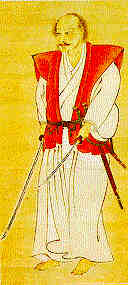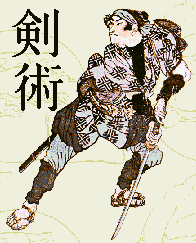
“There’s no need for you women to stay with
me. Hurry out!”
--the last words of Oda Nobunaga
|
|
|
|
|
|
|
|
|
|
|
|
|

“There’s no need for you women to stay with
me. Hurry out!”
--the last words of Oda Nobunaga
Upon his succession to his Father’s estate in
1551, Nobunaga controlled only one half of his native region of Oda, by
the time he died, he had unified over one third of Japan for this reason
he is considered one of the three great unifiers of Japan. Though
his methods may have been ruthless, his goal was to unify Japan (though
under himself of course). Before complete his mission in whole he
was assassinated in 1582.
In Feudal Ashikaga Japan, only one man could have absolute power—the Emperor, direct descendent of the Sun Line which was descended from the god Ameratsu. However, in all actuality matters which were theoretically to be dealt with by the Emperor were dealt with by the Fujiwara family instead. And the military power of Japan was in the hands of the Shogun, who became so powerful by means of his military might, that he was the most formidable man the country. His strength lay in his samurai, the military class, who swore oaths of allegiance to him.
The Onin War changed all that. For 100 years the mightiest lords
of Japan raised armies and did battle with one another, each contending
to become the new Shogun. This era saw the birth of the Daimyo, powerful
lords in possession of castles and samurai armies, each of whom was the
virtual king in his own sphere of influence. Samurai were brought
in from their farmland and placed into castle garrisons, thus breaking
their tie with the land. Many of the Daimyo were very accepting of
the newly arriving Christian missionaries, for with the Jesuits came guns.
The western firearms were studied and then replicated, and would come to
revolutionize Japanese warfare. He who knew how to employ his guns
the best (not necessarily he who had the most guns) usually came out on
top. Out of this period arose Oda Nobunaga.
Nobunaga was born in 1534 while his family was quickly becoming master of their native region of Owari. In 1551, much to the dismay of some of his own family, Oda Nobunaga, 17 years old, inherited his father’s estate. In 1558 Oda promoted a talented young ashigaru into his army named Toyotomi Hideyoshi, a man who would later come to be known as one of the three unifiers of Japan alongside Oda Nobunaga. Also in 1558, one of Oda’s castles was razed by the young Tokugawa Ieyasu (the third great unifier of Japan).
In 1560 Imagawa Yoshimoto set out to capture Kyoto with a samurai army 25,000 strong, the first province in his way was Nobunaga’s Owari. Imagawa’s army quickly captured two of Nobunaga’s castles. When Nobunaga was made aware of the situation he is said to have danced and sang:
A man lives for fifty years.
When compared with the Lowest Heaven,
It’s like a dream, an illusion.
Is there anyone who, given life once,
Never fades away?
(Sato, 234)
Then much to the dismay of Nobunaga’s advisors, he set out with his insignificant army of 2,000 to intercept the 25,000 strong army of Imagawa! Near a village named Okehazama, at the bottom of a mountain gorge, the army of Imagawa celebrated its recent victories. Much to surprise of Imagawa’s men, a large army deployed before them off in the distance. Little did they know, but it was actually an army of straw stuffed dummies. The clouds overhead broke and Imagawa’s troops scurried for shelter—no one fought battles in the rain. As Imagawa’s troops tried to stay dry and prepared to do battle with a straw army, Nobunaga’s small force crept around behind them. When the rain let up a little Nobunaga’s army charged down from the top of the gorge into the rear of Imagawa’s army. Imagawa stepped out from his tent, to see where the commotion was coming from and decided his own troops must have started brawling. By the time he realized what was actually happening, it was two late, two of Oda’s samurai rushed at Imagawa, the second of the two lopped of his head (Turnbull. The Samurai, 133). The bitterly short Battle of Okehazama thrust Oda Nobunaga into the forefront of the scurry for the shogunate. A year later Tokugawa Ieyasu joined Oda’s army.

In 1570 at the Battle of Anegawa, Oda Nobunaga faced off against the forces of Asai and Asakura. This time Oda outnumbered his foes two to one as the opposing armies drew up on opposite sides of the Anegawa River. The fighting took place in the middle of the river which was, at its deepest, one meter (Turnbull. Samurai Warfare, 124) Things did not go exactly as planned, nevertheless, Nobunaga’s army triumphed.
By 1571 Nobunaga’s many enemies had surrounded him and he had been forced to give ground until he was backed into Kyoto. The great majority of the troops surrounding him were Buddhist monk-soldiers. Oda gathered an army of 30,000 and descended upon Mount Hiei, the monastery-stronghold of his enemies. When his subcommanders questioned whether or not he should desecrate a Buddhist monastery Nobunaga replied: “I am not the destroyer of this monastery, the destroyer of the monastery is the monastery itself.” (Turnbull. The Samurai, 141). At dawn of September 29 Oda’s army started their way up the hill, killing everyone who got in their way regardless of age or sex. Old men, women, children, everyone was slaughtered, the temples and monastery, burned. After finishing off one Buddhist sect, the Ikko-Ikki still opposed him.
 In
1573 Oda Nobunaga’s greatest rival was accidentally shot and killed by
one of his own men. This allowed Oda to focus on attacking the Ikko-Ikki.
Oda’s army confronted the Ikko-Ikki at the Battle of Nagashio, about which
Stephen Turnbull says: “If Nagashino had been the only victory that Nobunaga
had ever won his reputation would still have been assured. Castle
Nagashino was an imposing sight, its high walls surrounded by two rivers.
The castle was defended by Nobunaga’s men against assaults, miners, rafts,
platforms, siege towers, etc. Whatever the enemy threw at them, they
withstood, so eventually the enemy army hunkered down to simply starve
the defenders out. A brave samurai named Torii managed to slip through
the besiegers and make his way to Nobunaga who promised relief. Oda
brought up an army of 38,000 to attack the besiegers. On June 29
1575 the battle began. Nobunaga has his army deployed behind a palisade,
in front of which were 3,000 matchlockmen firing in ranks to maintain a
constant hail of bullets, another force was detached to creep up behind
the enemy army. The enemy samurai were obliterated by the volleys
from the matchlocks, and when the garrison troops saw the battle going
their way they sallied forth and charged the enemy’s rear, those troops
still defending the palisades also joined in the hand-to-hand fighting.
The enemy army was slaughtered.
In
1573 Oda Nobunaga’s greatest rival was accidentally shot and killed by
one of his own men. This allowed Oda to focus on attacking the Ikko-Ikki.
Oda’s army confronted the Ikko-Ikki at the Battle of Nagashio, about which
Stephen Turnbull says: “If Nagashino had been the only victory that Nobunaga
had ever won his reputation would still have been assured. Castle
Nagashino was an imposing sight, its high walls surrounded by two rivers.
The castle was defended by Nobunaga’s men against assaults, miners, rafts,
platforms, siege towers, etc. Whatever the enemy threw at them, they
withstood, so eventually the enemy army hunkered down to simply starve
the defenders out. A brave samurai named Torii managed to slip through
the besiegers and make his way to Nobunaga who promised relief. Oda
brought up an army of 38,000 to attack the besiegers. On June 29
1575 the battle began. Nobunaga has his army deployed behind a palisade,
in front of which were 3,000 matchlockmen firing in ranks to maintain a
constant hail of bullets, another force was detached to creep up behind
the enemy army. The enemy samurai were obliterated by the volleys
from the matchlocks, and when the garrison troops saw the battle going
their way they sallied forth and charged the enemy’s rear, those troops
still defending the palisades also joined in the hand-to-hand fighting.
The enemy army was slaughtered.
After this period Oda had the castle Azuchi constructed. It was the largest, most elaborate, most defendable, and most luxurious castle that Japan had ever seen. Azuchi was to Japanese military architecture what the Battle of Nagashino was to Japanese military tactics.
On June 21, 1582 Akechi Mitsuhide decided to eliminate
his lord, and surrounded with his troops the shrine in which Oda was residing.
Oda was wounded by an arrow, which he promptly pulled from his leg and
began defending himself with a spear, as the few men with him were killed
one by one. When a bullet hit Nobunaga in the arm, he retreated into
a backroom of the shrine, which was now on fire, and ordered the women
present to leave him. He shut himself into the room alone and either
committed seppuku or was burned alive in the fire. The Great Daimyo
who had united one third of Japan was now dead.
By his detractors, Oda Nobunaga is known as a
ferocious and murderous ravager, responsible for the burning of villages
and the destruction of temples. These aspects of Nobunaga can in
no way be denied. But at the same time, Nobunaga and his feisty temper,
fought to unify Japan (under himself). Eventually Japan would be
unified, and Oda is considered the first of the three great unifiers along
with Toyotomi Hideyoshi, and Tokugawa Ieyasu. He is also famed for
his military strategy and his use of firearms in his battles which helped
revolutionize Japanese warfare.
Blomberg, Catharina. The Heart of the Warrior: Origins and Religious Background of the Samurai System in Feudal Japan. Japan Library, 1994. Ikegami, Eiko. The Taming of the Samurai: Honorific Individualism and the Making of Modern Japan. Harvard University Press, 1995. Sato, Hiroaki. Legends of the Samurai. The Overlook Press, 1995. Turnbull, Stephen. The Samurai: A Military History. Japan Library Press, 1996. ----Samurai Warfare. Arms and Armor Press, 1996. Yamamura, Kozo. The Cambridge History of Japan: Volume Three Medieval Japan. Cambridge University Press, 1990.
History of the Samurai www.northnet.org/americankangdukwon/samurai.html Provides a good history of the samurai (hence the name).
Chusingura www.ukans.edu/~sma/chushin/chushtxt.htm Information about Chusingura.
Samurai Archives samurai.bigsitecity.com/ All sorts of interesting samurai info.
Scatterway www.scatterway.com Utterly unrelated to samurai whatsoever, yet still an essential webpage for anyone studying the samurai.
Origins of the Samurai www.judoinfo.com/samurai.htm Detail into the background of the samurai and fighting techniques.